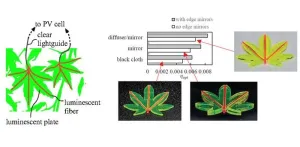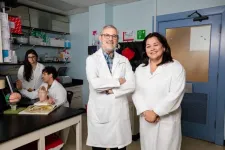(Press-News.org) Thomas Edison went through thousands of materials before he finally found the right tungsten filament to create a working lightbulb. This type of trial-and-error research continues today and is responsible for countless inventions that improve our world. Battery systems that help power our lives in many seen (and unseen) ways are one example.
However, improving these materials and devices requires more than experimentation. Modern engineers must also form a deeper understanding of the general principles that govern material performance, from which they can design better materials to achieve challenging product requirements.
In a paper published Aug. 13 in the Proceedings of the National Academy of Sciences (PNAS), University of Delaware, Northwestern University and industry researchers report expanded understanding on how electrons move through the conductive parts of complex fluids called slurries that are found in electrochemical devices such as batteries and other energy storage devices.
It’s important work that can help overcome existing knowledge gaps about how electrons hop between conductive particles found in these materials, as engineers seek new ways to improve that activity.
The paper is the result of collaborative research between UD’s Norman Wagner, Unidel Robert L. Pigford Chair in Chemical and Biomolecular Engineering, and researchers led by Jeffrey Richards, assistant professor of chemical and biological engineering at Northwestern University, and a former UD postdoctoral researcher. Lead authors on the paper include UD alumna Julie Hipp, who earned her doctoral degree in chemical and biomolecular engineering in 2020 and now is a senior scientist at Procter and Gamble, and Paolo Ramos, a former NU graduate student now at L’Oreal. NU doctoral candidate Qingsong Liu also contributed to this work.
According to Wagner, by combining carefully designed and conducted experiments with state-of-the-art theory and simulation, the research team found that enhancing performance requires more than formulation chemistry. It also requires understanding how the electrical conductivity behaves as the slurry materials are processed and manufactured.
“To control the device performance, it's not enough just to control the chemistry, we have to control the microstructure, too,” said Wagner. This is because the material’s final microstructure — meaning how all the components come together — regulates how the electrons can move, impacting the device’s power and efficiency.
Performance depends on the details
Though many electrochemical devices exist, let’s stay with the battery example for a moment to break things down.
Batteries supply electricity when electrons move through a solution or “slurry” made of conductive materials and solvents via a chemical reaction. How well the battery system works depends on the materials, which includes both the chemistry and the manufacturing processes used in its creation.
Think of it like multiple racecars going around a racetrack. All the racecars have steering wheels, tires and engines, but the structure of each vehicle and how it’s assembled may differ from car to car. So, just because a car with an engine and a steering wheel is on the track doesn’t mean it gets the same performance as the other vehicles. The same is true for the critical components in batteries. The details matter in how you put them together.
Conductive versions of carbon black (or soot) are commonly used in batteries as well as a vast number of electrochemical devices. They are nano-sized crystals of carbon made in such a way that they stick together and form aggregates, or clusters, that can be mixed with various liquids to form a slurry. This slurry is then used to cast, or make, parts of a battery or other devices.
“In that mixture, electrons can move very fast within the carbon black, which is highly conductive like an electrical wire. But the electrons have to hop from one cluster of carbon-black particles to another because the carbon black is suspended in the slurry — the aggregate particles are not connected as a solid structure,” explained Wagner.
The researchers had previously shown that the way the carbon black material flows — its rheology—plays a key role in the material’s performance, using neutron-scattering techniques at the National Institute of Standards and Technology’s Center for Neutron Research in Gaithersburg, Maryland, through UD’s Center for Neutron Science. In this new study, the research team extended that work to create a universal roadmap for understanding how the conductivity of the flowing slurry depends upon the chemistry of the components from which it is comprised and — importantly — how the slurry is processed.
Together, these pieces form a blueprint for how to process energy storage devices during manufacturing. The promise in this kind of roadmap is an enhanced ability to systematically design materials and predict the behavior for electrochemical devices on the front end.
“What we've studied allows us to begin to understand how the structure of this carbon-black slurry, this aggregated suspension, impacts the efficiency and performance of these devices,” said Wagner. “We're not solving anyone's specific battery problem. The hope is that others in practice can apply our foundational work to their own electrochemical systems and problems.”
The researchers expect this work will have an impact on the formulation and processing windows for emerging electrochemical energy storage methods and water deionization technologies.
Wagner gave the example of electrolyzer devices that use electricity to split water into its component parts of hydrogen and oxygen. One of the most challenging parts of this process is mixing and controlling the properties of the material solutions that enable the electrolyzer to do its work and free up hydrogen molecules so they can be used for other purposes, say, as an energy resource. According to Wagner, future improvements in such devices will depend on processing.
“You can get the chemistry right, but if you don't process it right, you don't end up with the performance that you want,” Wagner said.
END
Research provides a roadmap for improving electrochemical performance
New findings expand understanding about how electrons move in complex fluids in batteries and other similar devices
2024-08-16
ELSE PRESS RELEASES FROM THIS DATE:
Females’ and males’ muscles differ in sugar and fatty acid handling
2024-08-16
Females’ and males’ muscles differ in glucose and fatty acid handling – but regular physical activity quickly triggers similar beneficial metabolic changes in the muscles of both sexes, new research to be presented at this year’s Annual Meeting of the European Association for the Study of Diabetes (EASD) (Madrid, 9-13 September) has found.
Exercise has a potent effect on skeletal muscle and is the most effective strategy to prevent weight loss-related muscle loss and type 2 diabetes. ...
USDA-NIFA awards $300K to study food safety, plant pathogens and pests in hydroponics
2024-08-15
FAYETTEVILLE, Ark. — As controlled environment agriculture and vertical farming gain a greater foothold in modern agriculture, a new $300,000 grant aims to enhance hydroponic lettuce production.
Kristen Gibson, director of the Arkansas Center for Food Safety and Arkansas Agricultural Experiment Station faculty member, is the lead researcher on the grant from the U.S. Department of Agriculture’s National Institute of Food and Agriculture. Gibson says the grant provides an opportunity to meet the needs of the hydroponics industry.
“The industry is always looking for what’s going to help them grow the best product, increase profit and ...
YALE NEWS: Brain wiring is guided by activity even in very early development
2024-08-15
New Haven, Conn. — In humans, the process of learning is driven by different groups of cells in the brain firing together. For instance, when the neurons associated with the process of recognizing a dog begin to fire in a coordinated manner in response to the cells that encode the features of a dog — four legs, fur, a tail, etc. — a young child will eventually be able to identify dogs going forward. But brain wiring begins before humans are born, before they have experiences or senses like sight to guide this cellular circuitry. How does that happen?
In a new ...
Eyes on the field: How Texas A&M researchers are working to revolutionize NFL officiating
2024-08-15
Hamza Memon and Nicholas Panzo, students at Texas A&M University School of Engineering Medicine (ENMED), are leading an innovative project at the intersection of sports and ophthalmology to improve National Football League (NFL) officiating . Rooted deeply in Houston’s vibrant sports culture, these Class of 2026 students combine their interest in ophthalmology and their love for sports to contribute significantly to a groundbreaking project with the NFL.
The two students met during a summer engineering program and quickly bonded over their shared aspirations in sports and ophthalmology. This friendship led ...
Blind cavefish have extraordinary taste buds
2024-08-15
Over thousands of years, cavefish evolved and lost their vision, earning the moniker “the blind cavefish,” but some cavefish also developed an inordinate number of taste buds on the head and chin.
In a new study, now published in the Nature journal Communications Biology, scientists at the University of Cincinnati have determined when the taste buds start to appear in areas beyond the oral cavity. The study was supported by the National Science Foundation.
To begin, blind cavefish evolved in cave ponds in northeastern Mexico. They are pale pink and nearly translucent compared to their silvery counterparts ...
What the trained eye cannot see: Detecting movement defects in early stage Parkinson's disease
2024-08-15
A technique that uses videos and machine learning to quantify motor symptoms in early-stage Parkinson’s disease could help reveal signs of the disease and other movement disorders earlier, which could lead to better treatment outcomes.
In a study just published in Parkinsonism and Related Disorders, a team of researchers from the University of Florida and the Fixel Institute for Neurological Diseases shows that video assessment can help detect early Parkinsonism in an individual by comparing the movement of the left and right sides of their body. The approach, researchers say, exploits the fact ...
Leaf-like solar concentrators promise major boost in solar efficiency
2024-08-15
Since its invention in the 1970s, the luminescent solar concentrator (LSC) has aimed to enhance solar energy capture by using luminescent materials to convert and concentrate sunlight onto photovoltaic (PV) cells. Unlike traditional concentrators that rely on mirrors and lenses, LSCs can harvest diffuse light and have been used in applications such as building-integrated photovoltaics, where their semitransparent and colorful nature offers aesthetic benefits. However, scaling up LSCs to cover large areas has been challenging due to issues like self-absorption of photoluminescent (PL) photons within the waveguide. Researchers ...
UTEP awarded $2.5 M NIH grant to study nicotine dependence in women
2024-08-15
EL PASO, Texas (Aug. 15, 2024) — Researchers at The University of Texas at El Paso will undertake a new study that could lead to improved nicotine cessation treatments for women. The work is supported by a new $2.5 million grant from the National Institute on Drug Abuse (NIDA), part of the National Institutes of Health (NIH).
Principal investigator Laura O'Dell, Ph.D., a professor in the Department of Psychology at UTEP, will lead the multidisciplinary study into how stress produced by nicotine withdrawal is intensified by variations in ovarian hormones in women.
The study ...
DOE announces $10 million to support climate resilience centers across America
2024-08-15
WASHINGTON, D.C. – To support vulnerable communities responding to continued and extreme climate effects, the Department of Energy (DOE) today announced $10 million in funding for innovative Climate Resilience Centers (CRCs) in 10 different states. University-led research teams will leverage the world class modeling, data and research capabilities from DOE national laboratories customized for their local regions with a focus on climate prediction of weather hazard risks to better prepare communities. The CRCs are part of the Biden-Harris Administration’s Justice40 Initiative and are designed to ensure that all Americans are benefitting from scientific research.
“Every ...
Science in Space to Cure Disease on Earth—the International Space Station National Lab and NASA announce new funding opportunity
2024-08-15
KENNEDY SPACE CENTER (FL), August 15, 2024—The International Space Station (ISS) National Laboratory is collaborating with NASA on a solicitation for space-based research addressing some of the most significant diseases of our time—such as cancer, cardiovascular disease, and neurodegenerative disease. ISS National Lab Research Announcement (NLRA) 2024-09: Igniting Innovation: Science in Space to Cure Disease on Earth, released in partnership with NASA’s Biological and Physical Sciences division, is aimed at overcoming challenges hindering progress in disease prevention, diagnosis, and treatment. This NLRA ...
LAST 30 PRESS RELEASES:
Data-driven analysis reveals three archetypes of armed conflicts
Heart disease, stroke deaths down, yet still kill more in US than any other cause
Light switches made of ultra-thin semiconductor layers
Creative talent: has AI knocked humans out?
Sculpting complex, 3D nanostructures with a focused ion beam
A year after undermining Bredt’s rule, UCLA scientists have made cage-shaped, double-bonded molecules that defy expectations
Human activities drive global dryland greening
PeroCycle announces new appointments as it builds a world-class board for meaningful climate impact
Magnetic avalanches power solar flares
LeapSpace goes live: the Research-Grade AI-Assisted Workspace built on trusted science
DNA tests reveal mysterious beluga family trees
Strategic sex: Alaska’s beluga whales swap mates for long-term survival
How early cell membranes may have shaped the origins of life
Cannabis legalization is driving increases in marijuana use among U.S. adults with historically lower consumption rates
Multifunctional dipoles enabling enhanced ionic and electronic transport for high‑energy batteries
Triboelectric nanogenerators for future space missions
Advancing energy development with MBene: Chemical mechanism, AI, and applications in energy storage and harvesting
Heteroatom‑coordinated Fe–N4 catalysts for enhanced oxygen reduction in alkaline seawater zinc‑air batteries
Meta-device for precision lateral displacement sensing
Plasma-guided mitotane for the treatment of adrenocortical carcinoma: adjuvant care to advanced disease
Theoretical study of laser-enhanced nuclear fusion reactions
Social environment impacts sleep quality
Optimized kinetic pathways of active hydrogen generation at Cu2O/Cu heterojunction interfaces to enhance nitrate electroreduction to ammonia
New design playbook could unlock next generation high energy lithium ion batteries
Drones reveal how feral horse units keep boundaries
New AI tool removes bottleneck in animal movement analysis
Bubble netting knowledge spread by immigrant humpback whales
Discovery of bats remarkable navigation strategy revealed in new study
Urban tributaries identified as major sources of plastic chemical pollution in the Yangtze River
UK glaucoma cases higher than expected and projected to reach 1.6 million+ by 2060
[Press-News.org] Research provides a roadmap for improving electrochemical performanceNew findings expand understanding about how electrons move in complex fluids in batteries and other similar devices



